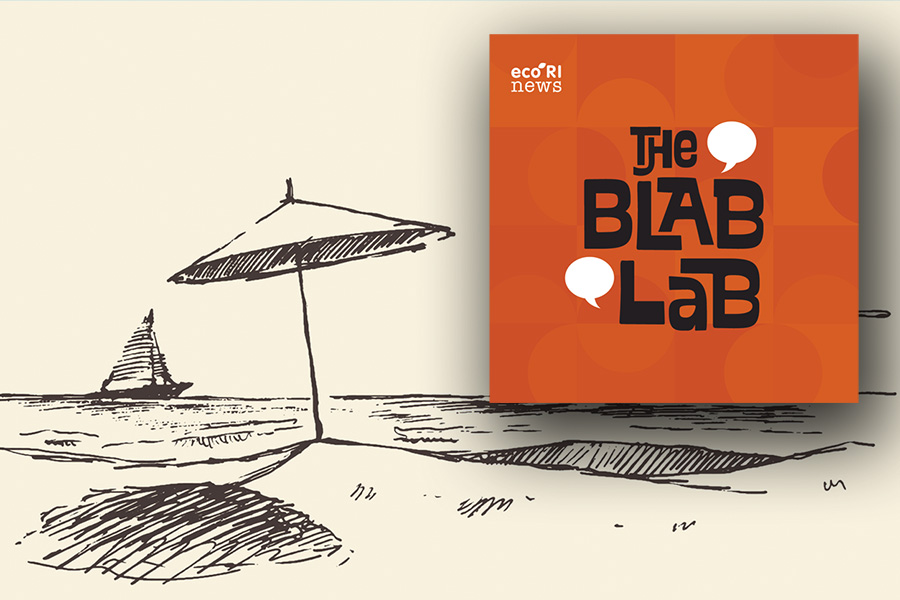Episode 2: What’s Affordable Housing Got to do with the Environment?
March 27, 2023
Subscribe and listen on iTunes, Spotify, Stitcher, or wherever you get your podcast
This transcript was edited for clarity and length.
Colleen Cronin
Welcome to the Blab Lab, ecoRI’s biweekly podcast on all things environmental and Rhode Island. I’m Reporter Colleen Cronin. For today’s episode, I’m here with reporters Rob Smith and Frank Carini to talk about affordable housing and how it connects the environment. Sometimes I tell people that I’m an environmental reporter, and I’m writing a story about affordable housing. And they look at me kind of funny. So that’s sort of what we’re here today to talk about. Frank, you’ve been in the business the longest — 32 years, why don’t you start.
Frank Carini
I’m old.
Rob Smith
Every time he comes on, you don’t have to like rub it in his face man.
Colleen Cronin
I was shocked that he’s been doing this 32 years. Because that’s … that’s longer than it than live.
Rob Smith
What’s the that Grandpa Simpson line? It’ll happen to you Colleen.
Colleen Cronin
So, Frank, in all reality, tell us tell us about sort of your take on affordable housing and how it connects to environmentalism.
Frank Carini
In the past, we’ve written about homelessness. We’ve written about affordable housing, we’ve written about other things that are social justice issues, and people will email or call to say, why are we writing about this. It’s outside of what you cover. And I have to explain to people that all these issues are interconnected. If we don’t solve one, we can’t solve the others. And affordable housing is part of that. Because it goes back to land use. In our previous episode, we spoke about how important land use is. And affordable housing is part of that; if we’re not gonna be able to take care of our own people, or humans, why are we going to take care of the other creatures we share this planet with or not? And we don’t. So it’s interconnected; you’ve run into it already, and you’ve only been here less than a year reporting, and you’re gonna run into it again. And I still run into it, but much less so than when we first started in 2009. I think, I’m hoping that people have learned to understand how these already connected. They are.
Colleen Cronin
I think that conservation and affordable housing can sound like they’re opposing ideas, but they’re really not. I’m working on a story. Ironically, about Legos which will come out eventually. Someone’s building LEGO model.
Rob Smith
Is that what’s his name? Andrew Grover.
Colleen Cronin
Yeah, he’s doing cool work. And a lot of times he’s doing urban buildings, but he’s actually going to be working on …
Frank Carini
What’s this gotta do with the environment?
Colleen Cronin
It does. It does. I swear, I swear. He made, a model of a building that’s historic. And he’s a, Providence resident, but he does a lot of hiking around Rhode Island. And he was talking about how, if you do urban well, you can do rural well, but when you do both badly, or when you do one badly, you end up doing both badly. And I thought that that was really interesting. And I think that I’ve talked to Scott Millar at Grow Smart RI, and he always talks about how, you know, they don’t have to be opposing, and maybe they need to work in tandem to actually get either accomplished. What is your experience with writing about affordable housing and the environment?
Rob Smith
I don’t think that conservation and affordable housing are really in conflict, it’s just that it’s one of those things that doesn’t really get a lot of funding, we don’t really have a lot of, there’s not a lot of guidance, and there’s not a lot of deliberate policy for preserving open space. No one’s making new parks anymore. It’s just grass. So it’s not really green space. But that’s basically put in by the pedestrian bridge on the old 195 Land is probably the most obvious example of like a new park. That’s just grass, which isn’t ideal, because grass is terrible for the environment. But parkland, forests, stuff you see in other parks is really good.
Frank Carini
So part of how it’s connected to the environment is building. We have finite resources on this planet. We’re gobbling them up. I’ll use Portsmouth as an example. Because I live there. All you see are these massive houses being built that are mansions that are second homes. There was one being built. It’s massive. I don’t know how big the square footage is. But it’s massive with a three-car garage. And we found out it’s two people that live there. So all these massive amount of finite resources lumber, used to build that home, that houses two that easily could house 20 or more. So that’s what affordable housing you could build. If you’re building these huge complexes for second homes, and people complain all the prices stuffs going up? Well, that’s going up because people are building second home these massive homes that aren’t helping anybody. So we’re going to run out of materials.
Rob Smith
And I think the common misconception is that cities are bad for the environment like overdeveloped urban spaces are worse for the environment than a suburban. Because the subdivision may have trees and grass and other plant life and cities don’t. I was reading a book called Green Metropolis. It advances the argument that cities are more dense and more efficient with resources. So if you are heating a six-story apartment building versus a single family home, it’s more efficient to heat the apartment building than the home because it’s all one building. You don’t have to pipe natural gas and heating oil further. And single-family homes lose and waste more heat. And so the buildings are much more energy efficient in terms electricity or heating. And to tie it back to affordable housing. Denser housing is more affordable, because as Frank alluded to, you’re using less finite material resources, whether it’s wood or concrete; it’s more efficient. And you’re not going to get to affordable housing by being by making starter homes anymore, especially in Rhode Island where space is premium.
Frank Carini
Colleen, you written about this, too. I mean, a lot of municipalities don’t even allow two-family homes, three-family homes; they don’t even allow these denser buildings that you need for affordable housing.
Colleen Cronin
Yeah, a lot of them don’t have the zoning to accommodate affordable housing, or what we traditionally think of as affordable housing, the housing that the state defines as affordable and the kind of housing that gets subsidies from the federal government. But that being said, a lot of those communities like, Middletown was the example that I used in my story that I recently wrote about affordable housing, because they’ve seen the greatest decrease in their percentage over the last 10 years. But half of the town has the infrastructure for affordable housing, and half of it doesn’t. So the parts of town that have the infrastructure are more friendly to that zoning. But there is an environmental argument that I’ve heard in Little Compton: There’s no public water, there’s no sewer anywhere in town, and very, very, very few parts of the town or so on to have any sort of multifamily housing, or mixed-use building. And part of the reason why people feel like that’s okay is because many parts of the town couldn’t accommodate multi unit, residents. There had been a proposal more than 10 years ago to build affordable housing for seniors in Compton. And people were concerned about the environmental effects of having so many units there, I think that there were going to be accommodations to make it work environmentally, like using a septic system. But I think that there are those concerns, and I, I when I hear them, I understand them.. But something that I think that about that people should still be able to live there, you know, even though even though Little Compton is not going to be the place that solves our affordable housing crisis. You know, don’t people have done people deserve to live in a beautiful place like that, even if they don’t make a ton of money? So my question then is, how do you solve that? And how do you put affordable housing there that works environmentally, but also people can afford? There’s a piece of property there that has six units, and that is the majority of the affordable agents in town. That’s worked out for people. But I just, I understand the argument that the denser housing is more efficient, and we shouldn’t be doing that. And that’s the, like low hanging fruit. But I don’t think that means that we shouldn’t also be talking about how housing could be better in those more fragile ecosystems that are using that environmental excuse to not let housing they’re like, how can we be more creative there? How can we give people access?
Frank Carini
So I don’t know if you’re looking into your story or reporting. But these people that are saying in Little Compton, they’re worried about septic … I would like to know how many people in Little Compton have cesspools still, or have failing septic systems. And if you have a failing septic system, it’d be interesting to know how these people that are, that are worried about that, how many of of them have failing septic systems because there’s, there’s a law now that if you sell if you’re within I think it’s 200 feet of wetlands are a waterbody, you have to before you sell your house, you have to get an updated septic system. But if you don’t sell you can keep using it. So it would be interesting to know how many of those people care about the existing problems that are there.
Colleen Cronin
Certainly, you know, there’s a septic system and it’s not a ton of units, but there’s a six unit affordable housing complex and I won’t even say that’s a complex … and they use septic and it works but you know, maybe it be that you have more of those around if you can’t do a three or four unit apartment, maybe you shouldn’t be doing more of this small accommodation in a place like Little Compton but it’s just not happening because it’s not happening. And that’s something that I am interested in. Well, thank you guys for coming on the podcast to talk about affordable housing. This has been The Blab Lab, ecoRI’s environmental news podcast. We want to thank Roger Williams University and Professor Bernardo Motta for letting us use the podcast studio here. We also want to thank Vanessa Carlton whose song Willow you hear at the beginning and the end of this podcast. If you have any questions or if this episode sparked any ideas for future stories or future episodes, please feel free to email me at [email protected].. Until next time, you can read us at ecoRI.org.
Categories
Join the Discussion
View CommentsYour support keeps our reporters on the environmental beat.
Reader support is at the core of our nonprofit news model. Together, we can keep the environment in the headlines.
We use cookies to improve your experience and deliver personalized content. View Cookie Settings



